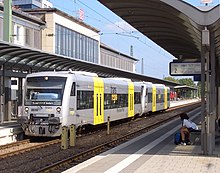Landstuhl–Kusel railway
From 1904, the Glan-Münchweiler–Altenglan section was also part of the Glan Valley Railway (Glantalbahn), which was built for strategic reasons, but closed for passenger services between 1961 and 1986.
In the early 1860s, the towns of Ramstein and Kusel, which at the time were part of the Kingdom of Bavaria, formed committees to promote the construction of a railway.
In the memorandum, it was argued that, among other things, the railway construction would improve the rather poor economic and social conditions of the region.
Cuttings were only necessary in the country around Rammelsbach, where the work force encountered a diorite deposit, which was mined in the following years and gave an additional impetus to rail transport.
On this day, a special train also ran from Ludwigshafen to Kusel, which carried, apart from officials of the Palatinate Railway (Pfalzbahn), the former Bavarian Minister of State for Trade and Public Works, Gustav Schlör.
The new line was very well received by the population, as it improved the infrastructure of the rural region northwest of Kaiserslautern.
Between Ramstein and Altenglan bells were used, with the intention of reducing the closing times at level crossings.
In 1890, Prussia and Bavaria negotiated a treaty to build a railway from Homburg to Bad Münster, envisaged as the shortest connection from the Saar to the Rhine.
As part of this duplication, the systems of tracks at Glan Munchweiler and Altenglan stations were also upgraded.
This was established as a possible detour in conjunction with the line to Türkismühle in case the Nahe Valley Railway between Ottweiler and Bad Münster became blocked.
A flood of the Kuselbach on 5 December 1965 closed operations between Altenglan and Kusel that evening and on the following day.
[12] During the 1950s many other adjacent routes in the western North Palatine Uplands were shut down, but the Kusel–Landstuhl line remained open due to its high freight revenue, mainly as a result of the surrounding quarries.
After passenger services were closed on the northern section of the neighbouring Glan Valley Railway from Lauterecken-Grumbach to Staudernheim in 1986, the line to Kusel and the Lauter Valley Railway were the only two lines in the region left with rail services.
While the costs of operating the Lauter Valley Railway could still be addressed, there was now no question of discontinuing passenger services between Landstuhl and Kusel.
This led in due time to some operational problems, as for example, in the same year, the line from Rammelsbach was heavily used by gravel trains to supply the construction of the Mannheim–Stuttgart high-speed railway.
[14] With the introduction of the Rhineland-Palatinate clock-face timetable in 1994, there were improvements to services on the line and it has since been served at least hourly.
This required the building of a passing loop at Ramstein halt, leading to the restoring of its classification as a station.
The Glan-Munchweiler–Altenglan section was integrated in the Glan Valley Railway, with the chainage initially starting in the west from Scheidt and running via St. Ingbert, Rohrbach and Homburg—now part of the Mannheim–Saarbrücken line—to Bad Münster.
With the opening of Glan Valley Railway there was an increase in services on the Glan-Munchweiler–Altenglan section, since this also was now part of the route between Homburg and Bad Münster.
[20][21] Freight traffic to the surrounding quarries always had great importance along the line, giving rise to the name of Steinbahn (stone railway).
[24] Several quarries also existed in the immediate vicinity of Altenglan, so the local station also had an extensive infrastructure for transferring freight.
[26] In September 2011, a 2.4 kilometre-long siding was opened, branching off the route south of Ramstein and connecting a woodworking company.
[27] At the opening of the Kusel–Landstuhl line, a class 1 B locomotive was used, although it was originally designed for hauling freight trains.
By the end of the winter 1974/75 timetable, Kaiserslautern locomotive depot (Bahnbetriebswerk) no longer operated steam engines of class 23 and 50 for hauling passenger trains.
Since December 2008, the section is mainly operated by DB Regio with modern diesel multiple units of class 643.




